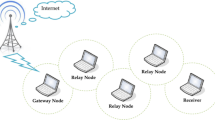Abstract
Next generation optical networks will soon provide users the capability to request and obtain end-to-end all optical 10 Gbps channels on demand. Individual users will use these channels to exchange large amounts of data and support applications for scientific collaborative work. These new applications, which expect steady transfer rates in the order of Gbps, will very likely use either TCP or a new transport layer protocol as the end-to-end communication protocol. In this paper, we investigate the performance of TCP and newer TCP versions over High Bandwidth Delay Product Channels (HBDPC), such as the on demand optical channels described above. In addition, we investigate the performance of these new TCP versions over wireless networks and according to old issues such as fairness. This is particularly important to make adoption decisions. Using simulations, we show that (1) the window-based mechanism of current TCP implementations is not suitable to achieve high link utilization and (2) congestion control mechanisms, such as the one utilized by TCP Vegas and Westwood are more appropriate and provide better performance. We also show that new TCP proposals, although perform better than current TCP versions, they still perform worse than TCP Vegas. In addition, we found that even though these newer versions improve TCP's performance over their original counterparts in HBDPC, they still have performance problems in wireless networks and present worse fairness problems than their old counterparts. We conclude that all these versions are still based on TCP's AIMD strategy or similar and therefore continue to be fairly blind in the way they increase and decrease their transmission rates. TCP will not be able to utilize the foreseen optical infrastructure adequately and support future applications if not redesigned to scale.
Similar content being viewed by others
References
L. Brakmo and L. Peterson, TCP Vegas: End to end congestion avoidance in a global Internet, IEEE Journal on Selected Areas in Communications 13(8) (1995) 1465–1480.
J. Bunn, J. Doyle, S. Low, H. Newman and S. Yip, Ultrascale network protocols for computing and science in the 21st century, White paper to DoE's Ultrascale Simulation for Science. Available at http://netlab.caltech.edu/FAST (2002).
First International Workshop on Protocols for Fast Long-Distance Networks, PFLDnet (2003); http://datatag.web.cern.ch/datatag/ pfldnet2003/index.html (February 2003).
S. Floyd, HighSpeed TCP for large congestion windows, IETF Internet draft (draft-floyd-tcp-highspeed-01.txt) (August 2002).
S. Floyd, Limited Slow Start for TCP with large congestion windows, IETF Internet draft (draft-floyd-tcp-slowstart-OI.txt) (August 2002).
S. Floyd and T. Henderson, The New Reno modification to TCP's fast recovery algorithm, RFC 2582, <http://www.ietf.org/rfc/rfc2582.txt> (April 1999).
S. Floyd and V. Jacobson, Random early detection gateways for congestion avoidance, IEEE/ACM Transactions on Networking 1(4) (August 1993) 397–413.
V. Jacobson, Congestion avoidance and control, in: Proceedings of SIGCOMM (1988) pp. 314-329.
V. Jacobson, Modified TCP congestion avoidance algorithm, Technical report (April 1990).
X. Jianxuan, S. Kerkar, M.A. Labrador and M. Guizani, Performance evaluation of TCP over optical links, in: Proceedings of IEEE ICC (2004) (to appear).
C. Jin, D. Wei and S. Low, FAST TCP for high-speed long-distance networks, IETF Internet draft (draft-jwl-tcp-fast-0l.txt) (June 2003).
A. Kamra, V. Misra and D. Towsley, Achieving high throughput in low multiplexed, high bandwidth, high delay environments, in: Proceedings of 1st International Workshop on Protocols for Fast Long-Distance Networks (February 2003).
D. Katabi, M. Handley and C. Rohrs, Congestion control for high bandwidth-delay product networks, in: Proceedings of ACM SIGCOMM (August 2002) pp. 89-102.
T. Kelly, Scalable TCP: Improving performance in highspeed wide area networks, in: Proceedings of International Workshop on Protocols for Fast Long-Distance Networks (February 2003).
S. Mascolo, C. Casetti, M. Gerla, M. Sanadidi and R. Wang, TCP Westwood: Bandwidth estimation for enhanced transport over wireless links, in: Mobile Computing and Networking (2001) pp. 287-297.
M. Mathis S. Floyd, J. Mahdavi and M. Podolsky, An extension to the Selective Acknowledgement (SACK) Option for TCP, RFC 2883, http://www.ietf.org/rfc/rfc2S83.txt (July 2000).
NS-2 Network Simulator, http://www.isi.edu/nsnam/ns/ (2000).
R. Pan, B. Prabhakar and K. Psounis, CHOKe-A stateless active queue management scheme for approximating fair bandwidth allocation, in: Proceedings of IEEE INFOCOM (April 2000) pp. 942-951.
E. Souza and D. Agarwal, A highSpeed TCP study: Characteristics and deployment issues, LBNL Technical report No. LBNL-532I5. Available at http://www-itg.lbl.gov/evandro/hstcp/.
L. Xu, K. Harfoush and I. Rhee, Binary increase congestion control for fast, long distance networks, in: Proceedings of INFOCOM (2004) (to appear).
Author information
Authors and Affiliations
Rights and permissions
About this article
Cite this article
Jianxuan, X., Labrador, M.A. & Guizani, M. Performance Evaluation of TCP over Optical Channels and Heterogeneous Networks. Cluster Computing 7, 225–238 (2004). https://doi.org/10.1023/B:CLUS.0000028001.95993.e9
Issue Date:
DOI: https://doi.org/10.1023/B:CLUS.0000028001.95993.e9




